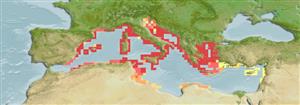Actinopterygii (ray-finned fishes) >
Perciformes (Perch-likes) >
Blenniidae (Combtooth blennies) > Salariinae
Etymology: Salaria: Latin, salar, salaris = trout (Ref. 45335).
Environment / Climate / Range
Ecology
Marine; freshwater; brackish; demersal; pH range: 6.5 - 7.5; dH range: 8 - 12. Subtropical; 18°C - 24°C (Ref. 13371), preferred ?; 47°N - 32°N, 7°W - 37°E
Europe and Africa: Africa: Rivers and brooks in Algeria and Morocco flowing to the Mediterranean; including Israel. Europe: Albania, Croatia, France, Greece, Italy, Montenegro and Spain (Ref. 26100); Portugal (Ref. 13612). Asia: Turkey.
Size / Weight / Age
Maturity: Lm ? range ? - ? cm
Max length : 15.4 cm TL male/unsexed; (Ref. 95757); common length : 8.0 cm TL male/unsexed; (Ref. 556)
Dorsal
spines
(total): 12 - 13;
Dorsal
soft rays
(total): 16-17;
Anal
spines: 2;
Anal
soft rays: 16 - 19;
Vertebrae: 36. This species is distinguished from its congeners in European inland waters by the following combination of characters: a broad diagonal band of tiny dots running from eye backward and downward; branched cirrus above eye; head length 25-31% SL; upper jaw with 16-24 teeth, lower jaw with 16-20; A II,16-19; D XII-XIII,16-17 (Ref. 59043).
Adults occur in rivers and brooks (Ref. 4342), in relatively shallow water as well as in low altitude lakes (Ref. 30578), on stone bottom; in streams, deepest and fastest microhabitats are preferred and sometimes coastal lagoons with low salinity (Ref. 59043). A territorial species that lives up to 5 years (Ref. 59043). Adults feed on small benthic organisms, aquatic insects and pupae (Ref. 94105). Oviparous (Ref. 205). Females spawn for the first time at the end of the first year and spawning lasts up to 3 years but with most females dying at the end of the first spawning year. One female spawns up to 1,200 eggs (usually 200-300) in a single layer under a large stone; spawns several egg portions during the season. On the other hand, the males clean, fan and defend the eggs until hatching. Several females may spawn with one male, which may guard the eggs at different stages of development (Ref. 59043). Eggs are demersal and adhesive; eggs hatch in about a week (Ref. 205, 59043). Planktonic larvae until about 1.5 cm, are drifted to and remain in quiet pools or side arms of rivers (Ref. 59043). Populations are threatened due to pollution and water abstraction (Ref. 26100); most riverine populations affected by habitat alteration (especially siltation and alteration of stream morphology), and predation of exotic species. Presence of habitat suitable for the pelagic 'larval' stage downstream of spawning sites is a limiting factor; lacustrine population are apparently safer (Ref. 59043).
Produces 200-300 eggs (Ref. 1672). Paternal care (Ref. 4342). Male cleans, fans and defends eggs until hatching. Several females spawn with one male, which may guard eggs at different stages of development. Eggs hatch in about a week (Ref.59043).
Bath, H., 1986. Blenniidae. p. 355-357. In J. Daget, J.-P. Gosse and D.F.E. Thys van den Audenaerde (eds.) Check-list of the freshwater fishes of Africa (CLOFFA). ISNB, Brussels, MRAC, Tervuren; and ORSTOM, Paris. Vol. 2. (Ref. 4342)
IUCN Red List Status (Ref. 115185)
CITES (Ref. 94142)
Not Evaluated
Threat to humans
Harmless
Human uses
Fisheries: of no interest; aquarium: commercial
More information
ReferencesAquacultureAquaculture profileStrainsGeneticsAllele frequenciesHeritabilityDiseasesProcessingMass conversion
Tools
Special reports
Download XML
Internet sources
